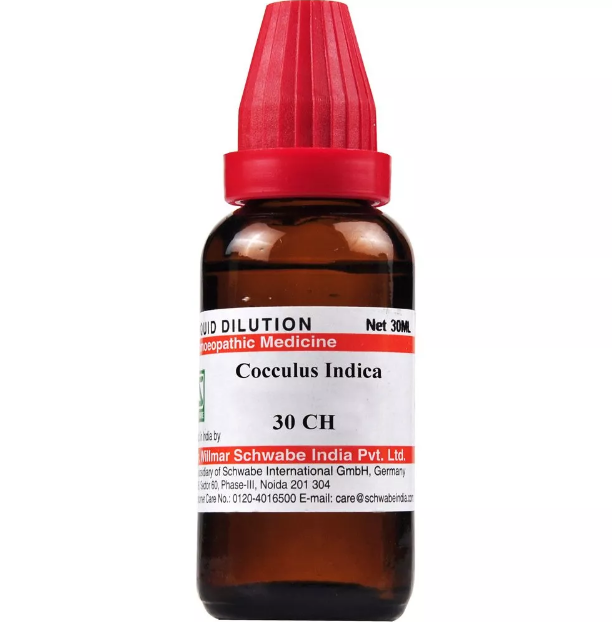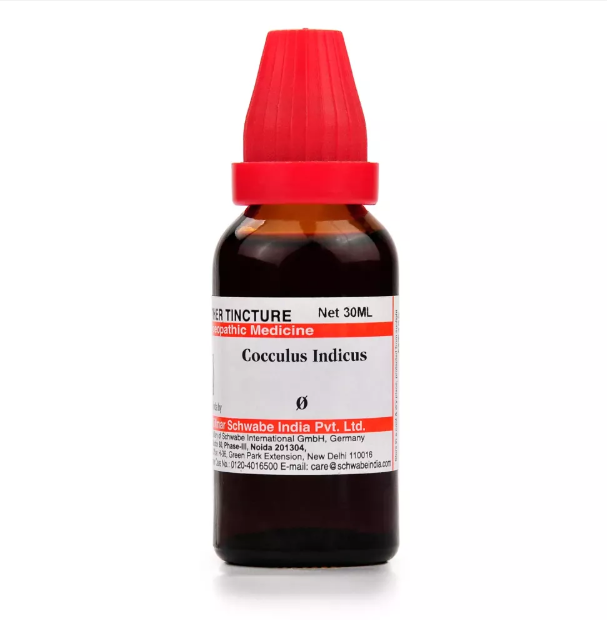COCCULUS INDICUS Q, 6C, 12C, 30C, 200C, 1M, 10M USES AND SYMPTOMS
 Cocculus Indicus
Cocculus Indicus
(Indian Cockle)
Cocc.
Cocculus Indicus affects many spasmodic and paretic conditions, particularly those impacting one side of the body. It targets the cerebrum but doesn’t cure convulsive seizures from the spinal cord (A. E. Hinsdale). It relieves painful limb and trunk contractures, tetanus, and the adverse effects of night watching. It is notably effective for light-haired females, especially during pregnancy, causing significant nausea and backache. It is also useful for unmarried and childless women, and sensitive, romantic girls. Symptoms worsen when riding in a carriage or on a boat, making it effective for seasickness. There is a sensation of hollowness or numbness, and a weakness that makes speaking loudly difficult.
Mind: Capricious, heavy, and slow. Time seems to pass quickly while absorbed in reveries. Irresistible urge to sing. Slow comprehension, mental numbness, profound sadness, inability to bear contradiction, hasty speech, and excessive concern for others’ health.
Head: Vertigo and nausea, especially when riding or sitting up. Sense of emptiness in the head. Headache in the occiput and nape, worse when lying on the back. Sick headache from riding in a carriage, inability to lie on the back. Pupils contracted, sensation of opening and shutting in the occiput, trembling of the head, and pain in the eyes as if they were being torn out.
Face: Paralysis of the facial nerve, cramp-like pain in the masseter muscle, worse when opening the mouth, and prosopalgia in the afternoon with wide-spreading pain.
Stomach: Nausea from riding in vehicles or looking at moving boats, worse when cold. Nausea with faintness and vomiting, aversion to food, drink, and tobacco. Metallic taste, paralysis of swallowing muscles, dryness in the esophagus, seasickness (Res. Ix), cramps during and after meals, hiccoughs, spasmodic yawning, loss of appetite, desire for cold drinks, especially beer, and disgust at the smell of food (Colch.).
Abdomen: Distended with wind, feeling as if full of sharp stones when moving, better when lying on one side. Pain in the abdominal ring as if something were being forced through. Weak abdominal muscles, with a sensation as if hernia might occur.
Female: Dysmenorrhea with profuse dark menses, menses too early and clotted with spasmodic colic. Painful pressing in the uterine region, followed by hemorrhoids. Purulent, gushing leucorrhea between menses, very weakening, with inability to speak and extreme weakness during menstruation.
Respiratory: Sensation of emptiness and cramps in the chest. Dyspnea from tracheal constriction, as if irritated by smoke. Choking constriction in the upper esophagus, causing respiratory oppression and inducing cough.
Back: Cracking of cervical vertebrae when moving the head, paralytic pain in the lumbosacral region, pain in shoulders and arms as if bruised, pressure in the scapula and nape, and stiffness when moving the shoulders.
Extremities: Lameness worsened by bending, trembling (chorea) and limb pain, arms falling asleep, one-sided paralysis worse after sleep, hands alternately hot and cold, numbness and cold sweat in hands, unsteady numbness, cracking knees on motion, very weak lower limbs, inflammatory knee swelling (arthritis), intensely painful paralytic drawing, limbs straightened out and painful when flexed.
Sleep: Spasmodic yawning, coma vigil, constant drowsiness after loss of sleep, night watching, and nursing.
Fever: Chills with flatulent colic, nausea, vertigo, cold lower extremities, heat in the head, general sweat, nervous low fever, and chilliness with perspiration and heat of skin.
Modalities: Worse with eating, after loss of sleep, in open air, smoking, riding, swimming, touch, noise, jar, afternoon, menstrual period, and after emotional disturbance.
Relationship: Antidotes: Coffea, Nux vomica. Compare with Picrotoxinum (epilepsy, morning attacks upon leaving horizontal position, hernia, locomotor ataxia, night sweats), Symphoricarpus racemosus (morning sickness), Petroleum, Pulsatilla, Ignatia.
SYMPTOMS OF COCCULUS INDICUS
Mind:
Capricious, heavy, and slow.
Time seems to pass quickly while absorbed in reveries.
Irresistible urge to sing.
Slow comprehension, mental numbness, profound sadness.
Inability to bear contradiction, hasty speech.
Excessive concern for others’ health.
Head:
Vertigo and nausea, especially when riding or sitting up.
Sense of emptiness in the head.
Headache in the occiput and nape, worse when lying on the back.
Sick headache from riding in a carriage, inability to lie on the back.
Pupils contracted, sensation of opening and shutting in the occiput.
Trembling of the head, pain in the eyes as if they were being torn out.
Face:
Paralysis of the facial nerve.
Cramp-like pain in the masseter muscle, worse when opening the mouth.
Prosopalgia in the afternoon with wide-spreading pain.
Stomach:
Nausea from riding in vehicles or looking at moving boats, worse when cold.
Nausea with faintness and vomiting.
Aversion to food, drink, and tobacco.
Metallic taste.
Paralysis of swallowing muscles.
Dryness in the esophagus.
Seasickness (Res. Ix).
Cramps during and after meals.
Hiccoughs, spasmodic yawning, loss of appetite.
Desire for cold drinks, especially beer.
Disgust at the smell of food (Colch.).
Abdomen:
Distended with wind, feeling as if full of sharp stones when moving, better when lying on one side.
Pain in the abdominal ring as if something were being forced through.
Weak abdominal muscles, with a sensation as if hernia might occur.
Female:
Dysmenorrhea with profuse dark menses.
Menses too early and clotted with spasmodic colic.
Painful pressing in the uterine region, followed by hemorrhoids.
Purulent, gushing leucorrhea between menses, very weakening.
Extreme weakness during menstruation, with difficulty speaking.
Respiratory:
Sensation of emptiness and cramps in the chest.
Dyspnea from tracheal constriction, as if irritated by smoke.
Choking constriction in the upper esophagus, causing respiratory oppression and inducing cough.
Back:
Cracking of cervical vertebrae when moving the head.
Paralytic pain in the lumbosacral region.
Pain in shoulders and arms as if bruised.
Pressure in the scapula and nape, stiffness when moving the shoulders.
Extremities:
Lameness worsened by bending.
Trembling (chorea) and limb pain.
Arms falling asleep.
One-sided paralysis worse after sleep.
Hands alternately hot and cold, numbness and cold sweat in hands.
Unsteady numbness.
Cracking knees on motion.
Very weak lower limbs.
Inflammatory knee swelling (arthritis).
Intensely painful paralytic drawing.
Limbs straightened out and painful when flexed.
Sleep:
Spasmodic yawning.
Coma vigil.
Constant drowsiness after loss of sleep, night watching, and nursing.
Fever:
Chills with flatulent colic, nausea, vertigo, cold lower extremities, and heat in the head.
General sweat.
Nervous low fever.
Chilliness with perspiration and heat of skin.
Modalities:
Symptoms worsen with eating, after loss of sleep, in open air, smoking, riding, swimming, touch, noise, jar, afternoon, menstrual period, and after emotional disturbance.
selection of the potency
Individualization:
- Homeopathy is based on the principle of treating the individual, not just the disease. The unique symptoms and characteristics of the person are crucial in determining the most suitable potency.
Intensity of Symptoms:
- The intensity of the symptoms guides the choice of potency. If the symptoms are intense and acute, a lower potency (e.g., 6C, 30C) might be considered. For chronic conditions with less intensity, higher potencies (e.g., 200C, 1M) may be appropriate.
Sensitivity of the Patient:
- Some individuals are more sensitive to homeopathic remedies, while others may require higher potencies. The practitioner considers the patient’s sensitivity when selecting the potency.
Acute vs. Chronic Conditions:
- Lower potencies are often used for acute conditions, while higher potencies may be considered for chronic or long-standing issues.
Previous Response to Potencies:
- The patient’s response to previous homeopathic treatments helps guide the choice of potency. If a particular potency has been effective in the past, it may be repeated or adjusted as needed.
Vital Force and Susceptibility:
- Homeopathy views illness as a disturbance in the vital force. The practitioner assesses the patient’s overall vitality and susceptibility to determine the appropriate potency.
Aggravation or Amelioration:
- The direction of the symptom response (aggravation or amelioration) after taking a remedy can influence the choice of potency.
Miasmatic Considerations:
- In classical homeopathy, the concept of miasms (inherited disease tendencies) is considered. The practitioner take this into account when selecting the potency.
Practitioner Experience:
- The experience and preference of the homeopathic practitioner play a role. Some practitioners may have success with certain potencies based on their clinical experience.
SAFETY INFORMATION
- Do not exceed the recommended dose by physician
- Keep out of the reach of children
- Store in a cool dry place away from direct sunlight
- Maintain half an hour gap between food/drink/any other medicines and homoeopathic medicine
- Avoid any strong smell in the mouth while taking medicine e.g. camphor, garlic, onion, coffee, hing
Medicine images use for reference only selection of homeopathic medicine depends on the individual’s specific symptoms and overall constitution. Moreover, homeopathy is a holistic system of medicine that treats the individual as a whole. In addition to addressing the physical symptoms, it takes into account the emotional and mental state of the person. Consequently, it’s crucial to consult with a qualified homeopathic practitioner for personalized treatment.
The information provided on this website is intended solely for educational purposes. Always seek the advice of your physician or other qualified health provider.
